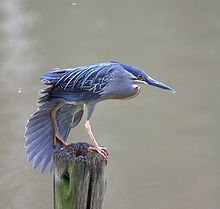- Striated Heron
-
Striated Heron 
Adult of nominate subspecies stretching itself in São Paulo Botanical Gardens. Conservation status Scientific classification Kingdom: Animalia Phylum: Chordata Class: Aves Order: Pelecaniformes Family: Ardeidae Genus: Butorides Species: B. striata Binomial name Butorides striata
(Linnaeus, 1758)Synonyms - Butorides striatus (lapsus)
- Butorides spodiogaster
The Striated Heron, Butorides striata, also known as Mangrove Heron, Little Heron or Green-backed Heron, is a small heron. Striated Herons are mostly non-migratory and noted for some interesting behavioral traits. Their breeding habitat is small wetlands in the Old World tropics from west Africa to Japan and Australia, and in South America. Vagrants have been recorded on oceanic islands, such as Chuuk and Yap in the Federated States of Micronesia, the Marianas and Palau; the bird recorded on Yap on February 25, 1991, was from a continental Asian rather than from a Melanesian population, while the origin of the bird seen on Palau on May 3, 2005 was not clear.[1]
This bird was long considered to be conspecific with the closely related North American species, the Green Heron, which is now usually separated as B. virescens, as well as the Lava Heron of the Galápagos Islands (now B. sundevalli, but often included in B. striata, e.g. by BirdLife International[2]); collectively they were called "green-backed herons".
Description and ecology
 Striated Heron photographed in Abu Dhabi, UAE
Striated Heron photographed in Abu Dhabi, UAE
 Subspecies B. s. spodiogaster, illustration by Keulemans, 1898
Subspecies B. s. spodiogaster, illustration by Keulemans, 1898
Adults have a blue-grey back and wings, white underparts, a black cap and short yellow legs. Juveniles are browner above and streaked below.
These birds stand still at the water's edge and wait to ambush prey, but are easier to see than many small heron species. They mainly eat small fish, frogs and aquatic insects. They sometimes use bait, dropping a feather or leaf carefully on the water surface and picking fish that come to investigate[3].
They nest in a platform of sticks measuring between 20–40 cm long and 0.5–5 mm thick. The entire nest measures some 40–50 cm wide and 8–10 cm high outside, with an inner depression 20 cm wide and 4–5 cm deep. It is usually built in not too high off the ground in shrubs or trees but sometimes in sheltered locations on the ground, and often near water. The clutch is 2–5 eggs, which are pale blue and measure around 36 by 28 mm.[4]
An adult bird was once observed in a peculiar and mysterious behavior: while on the nest, it would grab a stick in its bill and make a rapid back-and-forth motion with the head, like a sewing machine's needle. The significance of this behavior is completely unknown: While such movements occur in many other nesting birds where they seem to compact the nest, move the eggs, or dislodge parasites, neither seems to have been the case in this particular Striated Heron.[4]
Young birds will give a display when they feel threatened, by stretching out their necks and pointing the bill skywards. In how far this would deter predators is not known.[4]
Widespread and generally common, the Striated Heron is classified as a Species of Least Concern by the IUCN; this holds true whether the Lava Heron is included in B. striata or not.[2]
Footnotes
References
- BirdLife International (BLI) (2008). Butorides striata. In: IUCN 2008. IUCN Red List of Threatened Species. Downloaded on 7 January 2008.
- Boswall, J. (1983): Tool-using and related behavior in birds: more notes. Avicultural Magazine 89: 94–108.
- Greeney, Harold F. & Merino M., Paúl A. (2006): Notes on breeding birds from the Cuyabeno Faunistic Reserve in northeastern Ecuador. Boletín de la Sociedad Antioqueña de Ornitología 16(2): 46–57. PDF fulltext
- Norris, D. (1975): Green Heron (Butorides virescens) uses feather lure for fishing. American Birds 29: 652–654.
- Robinson, S.K. (1994): Use of bait and lures by Green-backed Herons in Amazonian Peru. Wilson Bulletin 106(3): 569–571
- Walsh, J.F.; Grunewald, J. & Grunewald, B. (1985): Green-backed Herons (Butorides striatus) possibly using a lure and using apparent bait. J. Ornithol. 126: 439–442.
- Wiles, Gary J.; Worthington, David J.; Beck, Robert E. Jr.; Pratt, H. Douglas; Aguon, Celestino F. & Pyle, Robert L. (2000): Noteworthy Bird Records for Micronesia, with a Summary of Raptor Sightings in the Mariana Islands, 1988–1999. Micronesica 32(2): 257–284. PDF fulltext
- VanderWerf, Eric A.; Wiles, Gary J.; Marshall, Ann P. & Knecht, Melia (2006): Observations of migrants and other birds in Palau, April–May 2005, including the first Micronesian record of a Richard's Pipit. Micronesica 39(1): 11–29. PDF fulltext
Categories:- IUCN Red List least concern species
- Butorides
- Herons
- Birds of Guyana
- Birds of Asia
- Birds of Trinidad and Tobago
- Birds of Pakistan
- Birds of India
- Birds of Sri Lanka
- Birds of China
- Birds of Korea
- Birds of Japan
- Birds of Southeast Asia
- Birds of Bangladesh
- Birds of Bhutan
- Birds of Burma
- Birds of Vietnam
- Birds of Cambodia
- Birds of Thailand
- Birds of Turkey
- Birds of Malaysia
- Birds of Singapore
- Birds of Brunei
- Birds of Indonesia
- Birds of the Philippines
- Birds of Western Australia
- Animals described in 1758
- Birds of Puerto Rico
Wikimedia Foundation. 2010.




